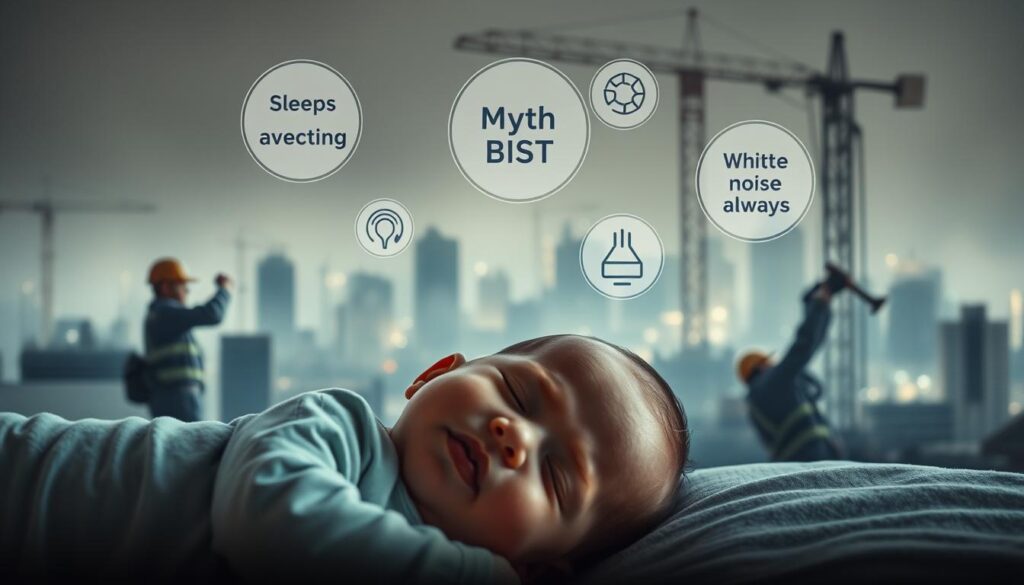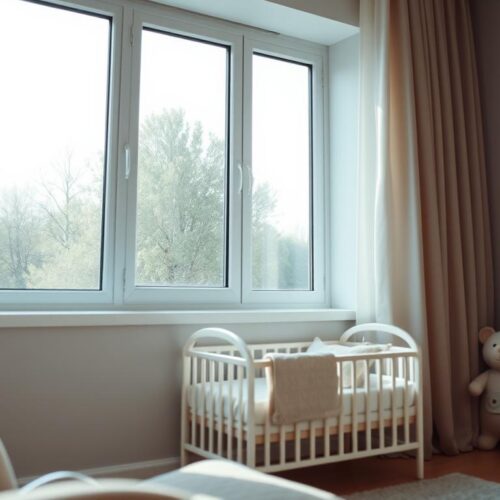As a parent or caregiver, dealing with construction noise and babies might be tough. It’s important to know how these noises affect your baby’s comfort and growth. Here, we’ll talk about why it’s key to keep babies safe from loud sounds. Especially near construction areas. We’ll give you important tips to lessen the noise’s effect on little ones, helping them stay happy despite the racket.
Understanding Construction Noise and Its Sources
Construction sites are noisy because of many things. For example, heavy machines like bulldozers and excavators make a lot of noise. Drilling and hammering add to this noise. Each activity creates a different kind of sound, which can be loud or soft, and continuous or come and go.
When we talk about construction noise, there are two main types: external and internal. Keeping outside noise from coming in is called soundproofing. Reducing echoes inside a space is known as sound absorption. Knowing the difference helps in finding the best ways to lower noise levels.
Getting to know these ideas is key to dealing with construction noise. The first step is figuring out where the noise is coming from. Then, you can choose how to lessen its effect on where you live.
The Impact of Construction Noise on Infants
Babies are really sensitive to loud noises, more than adults. Construction sounds can mess up their sleeping and eating. This doesn’t just make them upset now. It can also harm them later in life.
Loud noises can make babies cranky. Parents then look for ways to keep things quiet. If babies hear too much noise for too long, they might start acting differently. It’s key for those taking care of them to know this.
Knowing how construction noise affects babies helps you protect them. Creating a quiet space is important. It can make your baby feel better while work is going on.
Effects of Loud Noise on Baby Development
Parents must understand how loud noise affects baby growth. Studies show that too much noise can harm an infant’s development. High noise levels can cause problems in thinking and feeling in babies. It’s essential to know these risks early.
Detrimental Effects of Noise Exposure
Noise can be harmful to babies in many ways. Babies in loud places may feel more anxious and stressed. This stress can make it hard for them to bond with their parents. Also, too much noise can make it tough for them to learn to talk and listen. These issues can lead to learning problems later on.
Long-Term Consequences for Hearing
Long-term hearing damage is a big worry for parents. Noise over time can cause Noise-Induced Hearing Loss (NIHL). This can permanently harm a baby’s hearing. It’s crucial to act early and keep noises low. A quieter space helps babies grow better without the harm of loud noises.
Why Babies Are More Vulnerable to Noise
Babies are especially vulnerable to noise because their ears aren’t fully developed. Their auditory system isn’t as robust as an adult’s, making loud sounds more harmful. This is why loud noises often upset them, leading to crying or discomfort.
Babies react differently to noises, like loud construction sounds, than adults do. These noises trigger their stress response, causing trouble with sleeping or eating. This stress can upset their emotional health over time.
Loud noises can also hurt a baby’s emotional growth in the long run. Being exposed to too much noise can make it hard for them to manage their feelings. It might also slow down their progress in reaching important growth milestones. It’s crucial to know why infants are sensitive to sound to protect them.
How to Reduce Construction Noise Around Babies
Reducing construction noise around babies can seem tough. Yet, parents and caregivers have effective ways to make things calmer. Soundproofing is key to cut down on unwanted noise. White noise machines also help by covering up loud sounds with soothing ones.
Soundproofing Techniques for Homes
Soundproofing your home can really help control construction noise. Let’s look at some good methods:
- Seal windows and doors with foam weatherstripping to block sound leaks.
- Use acoustic curtains, which are designed to dampen noise levels effectively.
- Install sound absorber panels on walls to further minimize sound transmission.
- Consider adding area rugs or carpets that can help absorb sound from hard floors.
Using White Noise Machines
White noise machines are great for making things more comfy during construction. They create a steady sound that drowns out annoying noises. This helps babies sleep better. There are many models with different sounds to choose from, so you can find the perfect one for your baby.
Tips for Creating a Quiet Environment for Babies Near Construction Sites
Making a quiet space for your baby close to construction can be tough. Using good soundproofing in homes can make your place better. Here are some useful tips to cut down on noise, so your baby can stay comfy and not be disturbed.
Effective Use of Curtains and Rugs
Thick curtains work well to keep noise out. Heavier curtains also keep out light and lessen the noise that gets in. Putting rugs on hard floors also cuts down on noise and echo, making a nicer place for your baby.
Sealing Gaps in Windows and Doors
Fixing gaps in windows and doors helps a lot with noise. Weatherstripping creates a tight seal to block unwanted noise. This easy step also helps keep your place warm or cool, saving on energy through the year.
| Soundproofing Method | Benefits |
|---|---|
| Thick Curtains | Blocks light and reduces noise from outside |
| Area Rugs | Dampens sound and minimizes echo in the room |
| Weatherstripping | Seals gaps in windows and doors for improved sound isolation |
Health Risks of Construction Noise Exposure to Infants
Construction noise is a big risk to infants’ health. Loud noises for a long time can cause health problems. This is because infants are still growing and can be easily affected.
Sleep is very important for infants as it helps them grow and learn. But loud noises can ruin their sleep. This can make them more anxious. It can also slow down how they learn to talk and communicate.
Loud noises can also damage infants’ hearing. This is known as Noise-Induced Hearing Loss (NIHL). It can affect how they hear sounds and talk to others. Parents need to keep their babies away from loud construction sites.
Managing Construction Noise When Caring for a Baby
Dealing with construction noise while caring for a baby is a big challenge for parents. Noise during key sleep times can interrupt a baby’s sleep. This can affect their growth and mood. Planning your baby’s sleep schedule carefully can help avoid these issues. This ensures your baby sleeps well.
Planning Baby’s Sleep Schedule Around Construction
To deal with construction noise, you can adjust the baby’s sleep schedule. Consider these strategies:
- Check the construction schedule nearby and note when it’s quieter.
- Plan naps for those less noisy times, so your baby sleeps better.
- Keep a regular sleep routine, changing it if needed because of noise.
- Stay flexible with your plans as construction times might shift.
- Use soundproofing like heavy curtains or white noise machines to block noise.
By making these changes, you can create a calm space for your baby. This helps them sleep well, even with construction noise around.
Noise Reduction Techniques for Parents with Babies Near Construction Activities
Living near construction can be hard for parents with young kids. Using noise reduction methods can make your home better. Looking into special sound control options can help keep your baby’s space quiet.
Utilizing Acoustical Treatments
Sound control treatments can really help lower noise. Things like custom panels or blankets catch sound better than usual methods. Here are some things to try:
- Acoustic Panels: You can put these on walls or ceilings to cut down on noise bouncing around.
- Acoustic Blankets: Hang these blankets on windows or doors to block noise coming in from outside.
- Soundproof Curtains: These thick curtains block noise and light from getting through.
Also, think about where your furniture is placed. Putting bookshelves, big cushions, or bulky furniture by walls you share with neighbors can help quiet things down.
Common Myths About Noise and Baby Safety
Learning about noise and baby safety myths can help when living near construction. It’s not true that all noise hurts infants. In fact, while too much noise is risky, some sounds are okay. Babies can handle different noises better than some parents think.
Many believe babies can get used to any noise level. This idea simplifies how they tune out background noise. You shouldn’t make your child listen to loud sounds all the time. But, now and then, in a controlled setting, might not be harmful.
Loud noise should be kept to a minimum, especially when babies are growing. There are ways to keep your baby’s space quiet without believing in myths. Knowing these myths lets you choose what’s best for your child’s well-being.

| Misinformation | Reality |
|---|---|
| All noise is harmful to babies. | Moderate sounds are generally not harmful; excessive noise is the primary concern. |
| Babies adapt to all noise levels without issue. | Occasional exposure may be manageable, but chronic loud noise can lead to problems. |
| Silence is essential for baby health. | A balanced sound environment can be beneficial. Background noise can aid sleep. |
Legal Regulations Surrounding Construction Noise
It’s crucial for those living near construction, especially families with young kids, to know the legal rules about construction noise. Cities have rules to manage noise, mainly in crowded areas. These rules set certain times for construction and how loud it can be. Getting to know these laws can help you deal with loud construction work.
Understanding Local Noise Ordinances
Local noise rules are important for both people living near construction and the companies doing the work. They reduce disturbances that can affect life at home, especially for those with babies. Each place has its own rules about noise levels and when construction is allowed. Important points include:
- Allowed noise levels at different times
- Limits on construction at early or late hours
- Rules for emergency construction work
If construction breaks these noise rules, you can report it. This helps protect your family from too much noise.
| City | Noisy Hours (Weekdays) | Noisy Hours (Weekends) | Max Noise Level (dB) |
|---|---|---|---|
| New York | 7 AM – 6 PM | 10 AM – 4 PM | 85 |
| Los Angeles | 7 AM – 9 PM | 9 AM – 5 PM | 75 |
| Chicago | 8 AM – 8 PM | 9 AM – 5 PM | 70 |
Knowing your local noise rules helps you make smart choices about construction noise. Always watch for changes in these laws to maintain your family’s well-being.
Alternative Solutions for Noise Abatement
When we talk about construction noise, we need a plan that covers all bases, especially for kids. Getting the community involved in noise control and working together with construction companies can really make a difference. This way, we can find new ways to keep the noise down without troubling families too much.
Community Involvement in Noise Reduction
When community members talk about construction projects, noise pollution can be cut down. They can give tips on the best times for loud work, making it less of a hassle. Hosting community meetings can help everyone learn more and take joint action against noise. This teamwork makes it easier for builders to get how this noise affects families living close by.
Consulting with Construction Companies
Talking to construction companies is key. They need to know using less noisy tools and methods helps everyone. Things like sound walls, using quieter machines, and keeping the shakes to a minimum can really help. Working together, we can find cool new ways that keep both the builders and the community happy.
Preventing Excessive Noise on Construction Sites
Construction companies are key in stopping too much noise. They can make work places better and keep communities happy. For instance, using less noisy machines can help make things quieter. Choosing electric or machines that don’t make much noise keeps neighborhoods peaceful.
Setting times when loud machines can be used is smart. It stops too much noise in the early morning or late at night. Telling people living nearby about work times makes them trust and understand more.
Putting up fences that block sound around sites also cuts down noise. These fences catch sound and bounce it away, making it nicer for people living close by. It’s important for those in charge to use these ways to get along well with the community.
Talking openly with the community helps reduce noise problems. Sharing plans and listening to what residents say shows care for their need for quiet. Working together on noise control, both builders and people living nearby can find good ways to deal with noise.
| Noise Control Measure | Description | Benefits |
|---|---|---|
| Quieter Machinery | Using electric or low-noise equipment | Reduces overall sound levels |
| Time Restrictions | Limiting noisy equipment operation hours | Minimizes disturbances during sensitive hours |
| Sound Barrier Fencing | Installing barriers around the site | Absorbs and redirects sound waves |
| Community Communication | Keeping residents informed about schedules | Builds trust and mitigates complaints |
The Role of Acoustical Professionals in Noise Management
Acoustical professionals are important in handling noise at construction sites near homes with babies. They know how to manage noise well. These pros can measure sound and find where too much noise comes from. This lets them reduce noise where it’s needed most.
They work with building teams to use the latest quiet-making tech and materials. This teamwork makes sure noise levels are safe and meet rules. It keeps people living nearby happier and healthier.
By using sound walls, special panels, and insulation, they cut down on annoying noise. Their work meets laws and makes places better for families with small kids. Hiring these experts helps parents feel sure that their homes will stay peaceful.
Engaging Neighbors for a Collective Solution
Many neighborhoods struggle with the loud noise from construction. This is especially hard for families with babies. By working together, neighbors can find ways to deal with this problem. They can team up to talk to local construction projects together.
Talking openly in your community helps everyone share what they’re worried about. Having neighborhood meetings can start talks with construction companies or local leaders. When everyone shares their thoughts and solutions, the community can come up with better ways to handle the noise. This teamwork can make things better for everyone.
Starting a group that focuses on the construction noise might be a good idea. This group can speak for everyone when talking to important people or companies. This way, everyone’s concerns are heard louder and clearer. It shows how working together can make a peaceful place to live.
| Strategy | Description | Benefit |
|---|---|---|
| Neighborhood Meetings | Gather affected families to discuss noise issues and solutions. | Encourages community engagement and shared problem-solving. |
| Coalition Building | Form a group focused on addressing construction noise collectively. | Strengthens neighborhood solidarity and improves negotiation power. |
| Communication with Authorities | Engage with local officials or construction companies regarding noise concerns. | Increases visibility of noise issues and fosters accountability. |
These efforts show working together can really make a difference. When neighbors help each other, they can make life easier during noisy construction. This is great for everyone but especially for families with babies.

The Importance of Communication During Construction
Communication is key in construction, especially near homes. It creates a sense of community and understanding. Informing neighbors about when the noise will happen lets them plan their day better.
Teams should talk openly about progress and disruptions. This builds trust with the local community. Regular updates and meetings help resolve issues and strengthen bonds.
Listening to residents improves the project and makes people feel valued. Good communication makes everything run smoother. It reduces problems between residents and builders. The aim is to live together peacefully while work is going on.
Conclusion
Construction noise is not just annoying; it’s a big issue for your baby’s health. Knowing where the noise comes from and how it affects your baby is important. This knowledge lets you protect your little ones and make your home safer.
To lessen the noise impact, try soundproofing or use white noise machines. It’s also important to know your local noise rules. Fight for better noise control on construction sites. This helps everyone in the neighborhood have a safer place to live.
In the end, knowing what to do and taking action matters the most. Keep your baby safe by using protective measures. Also, talk to your neighbors and those running the construction. Together, you can reduce noise stress. This will allow your baby to grow up in a peaceful environment.




